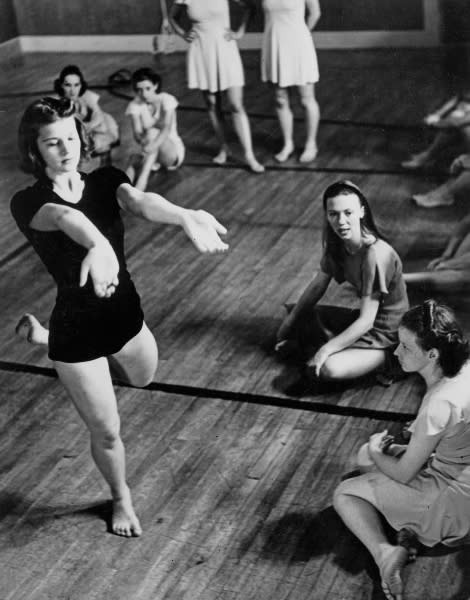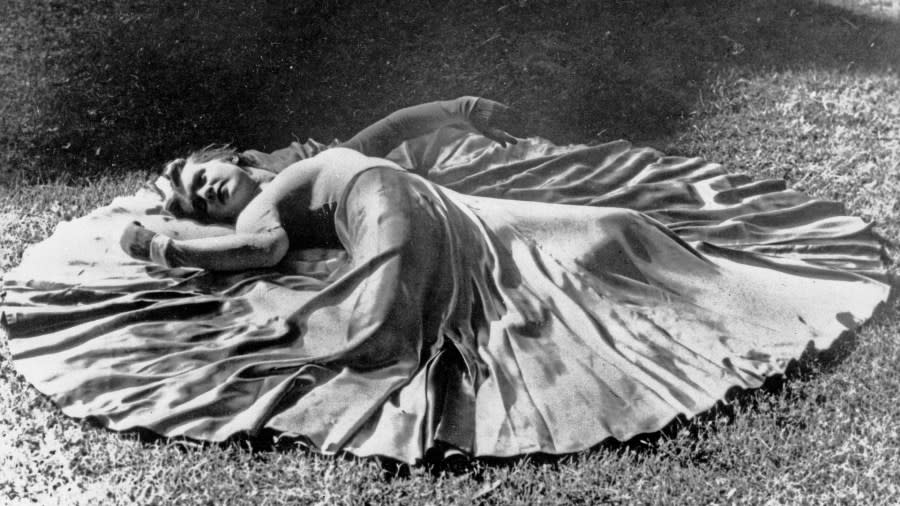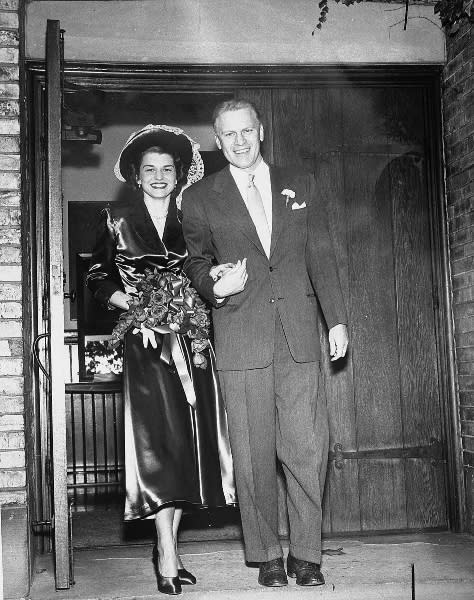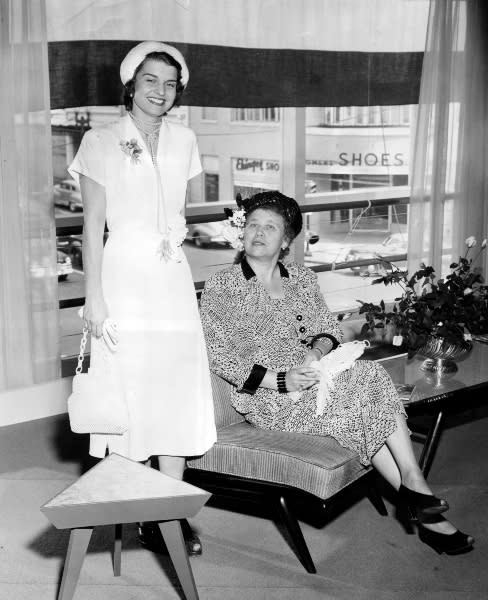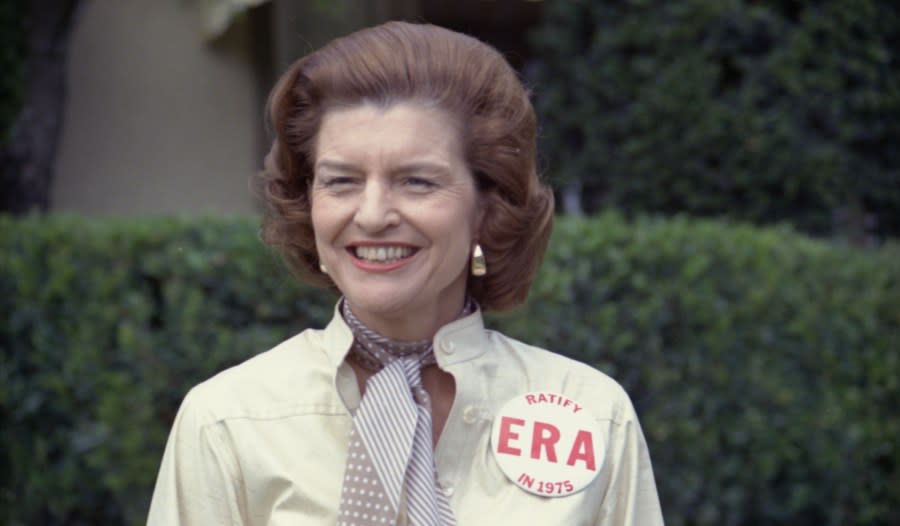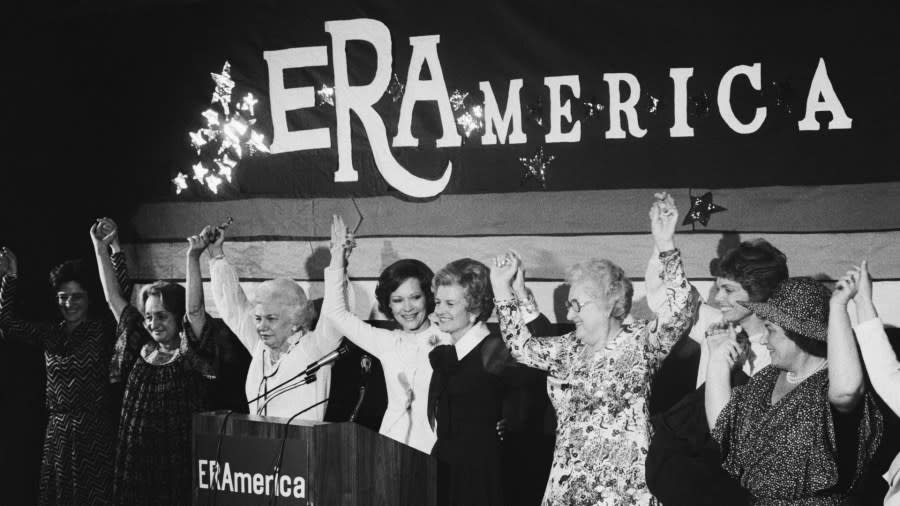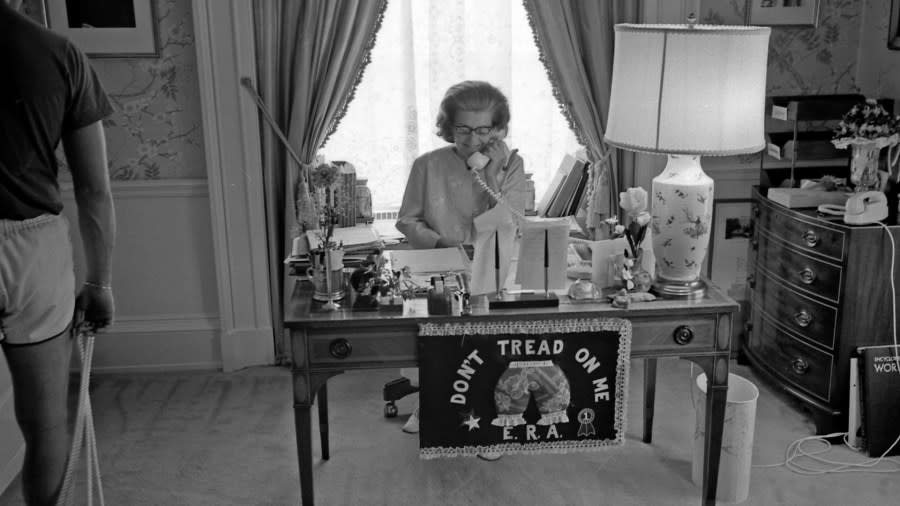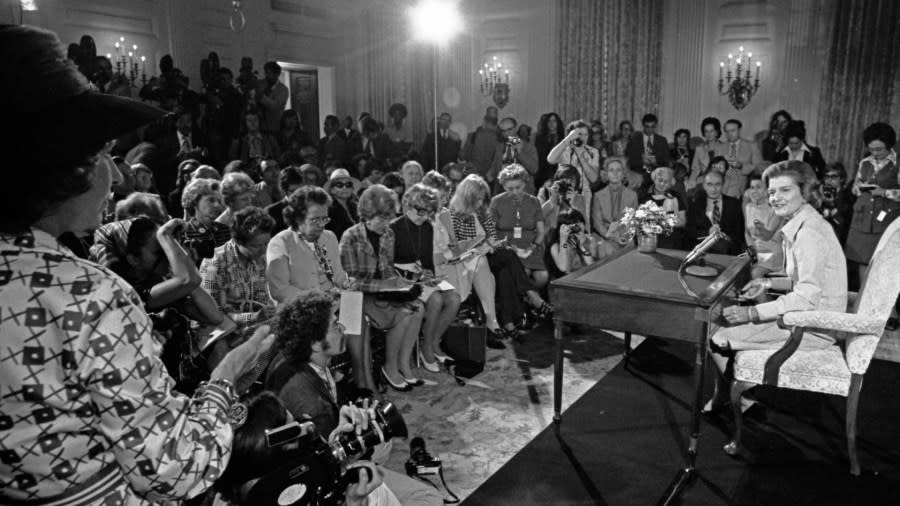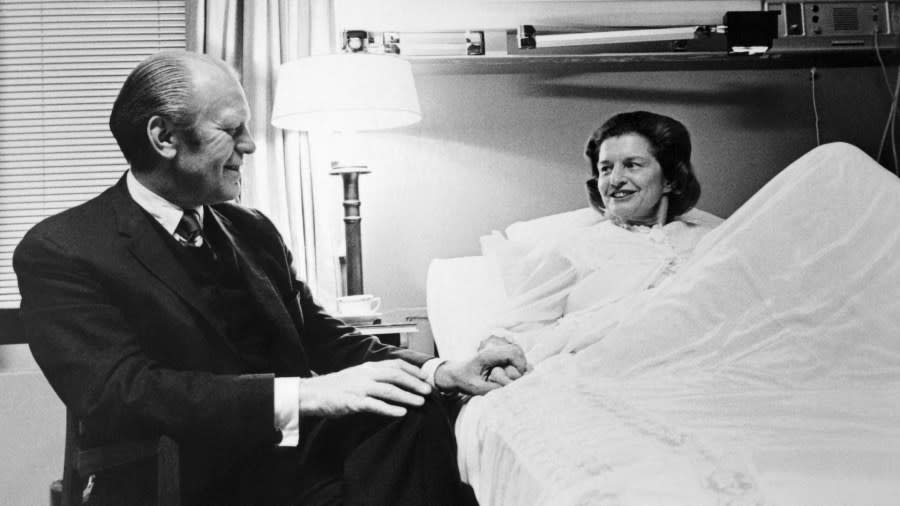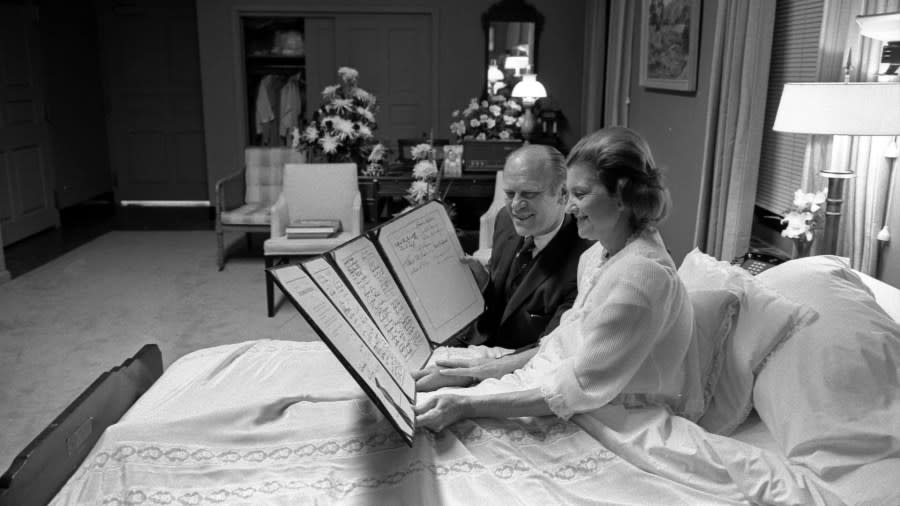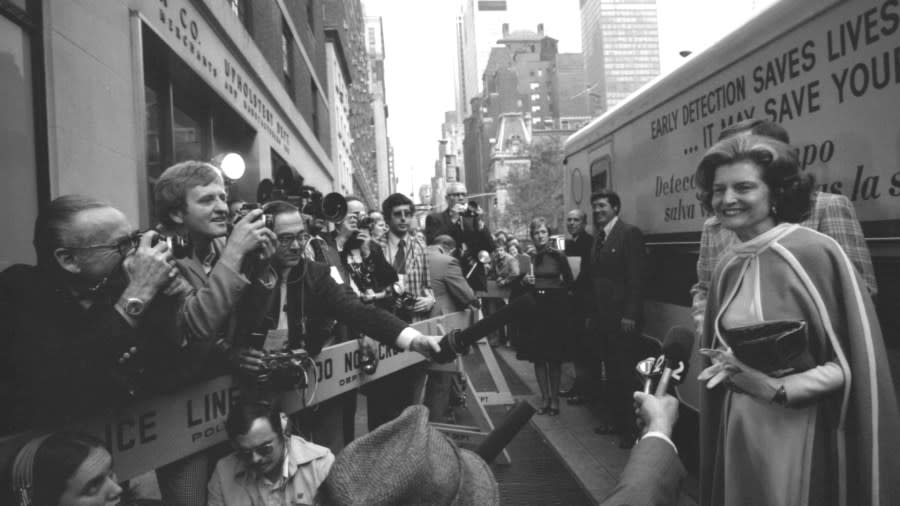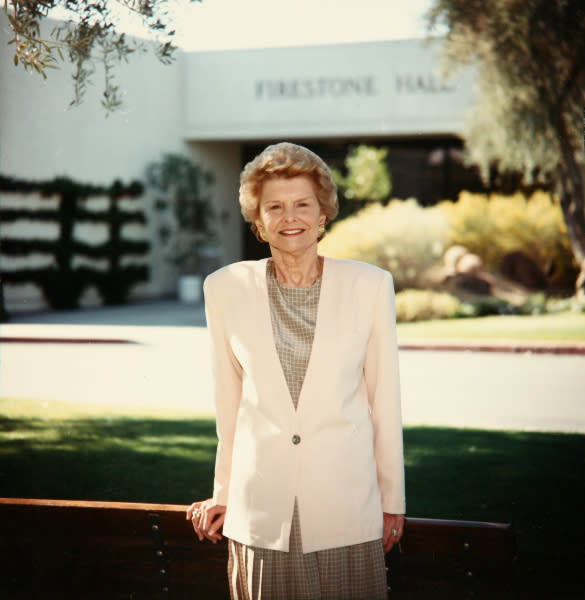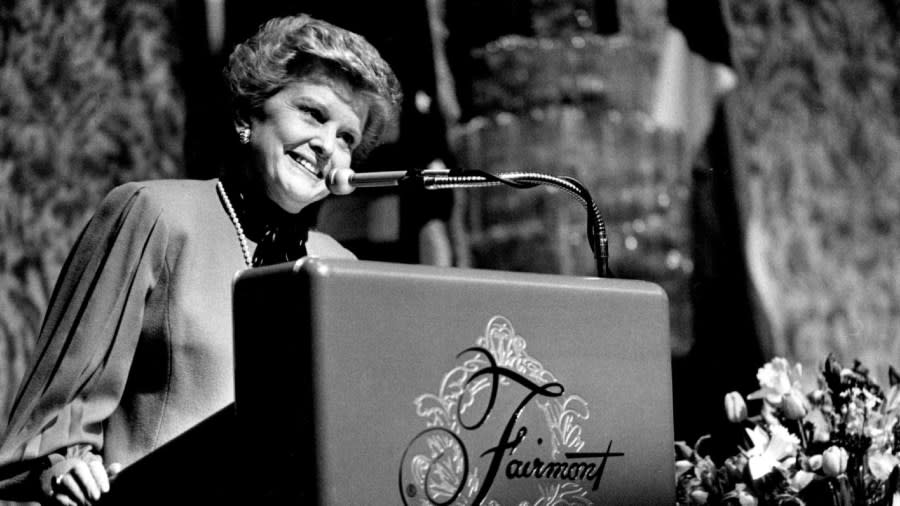Honesty, candor at the heart of Betty Ford’s legacy
- Oops!Something went wrong.Please try again later.
- Oops!Something went wrong.Please try again later.
- Oops!Something went wrong.Please try again later.
- Oops!Something went wrong.Please try again later.
- Oops!Something went wrong.Please try again later.
GRAND RAPIDS, Mich. (WOOD) — Though the role of America’s first lady has evolved over the years, the fine line they are forced to walk and the impact that they leave on the nation has not.
Whether it is serving as a hostess to foreign leaders or as a ceremonial representative of the “ideal” American spouse, every first lady has handled the job in their own way.
Betty Ford certainly did. She wasn’t exactly a fashion icon like Jackie Kennedy and didn’t serve as a dignitary quite like Eleanor Roosevelt, but Ford’s style and personality connected with the American public. You can see how her West Michigan roots shaped that persona.
A 1936 photo shows Betty Ford, left, and fellow dancer Mary Snapp perform in “Scenes from Scaramouche” at the Calla Travis School of Dance in Grand Rapids. (Courtesy Gerald R. Ford Presidential Library & Museum) A 1937 photo shows Betty Ford practicing in a class at the Bennington College Summer School of Dance in Bennington, Vermont. (Courtesy Gerald R. Ford Presidential Library & Museum) A 1942 photo shows Betty Ford in a sensuous pose in a benefit performance of “Fantasy.” At this time, Betty had returned to Grand Rapids and was an instructor at the Call Travis School of Dance. (Courtesy Gerald R. Ford Presidential Library & Museum) Gerald and Betty Ford walk out of Grace Episcopal Church after getting married on Oct. 15, 1948. (Courtesy Gerald R. Ford Presidential Library & Museum) A 1949 photo shows Betty Ford and her mother-in-law, Dorothy Gardner Ford, attending a luncheon at Herpolsheimers’ department store where Betty once worked as a fashion coordinator. (Courtesy Gerald R. Ford Presidential Library & Museum)
WHO WAS BETTY FORD?
The basics about Betty Ford are well known. She was raised in Grand Rapids and graduated from Central High School. She eventually married a young lawyer and worked alongside him as he climbed his way up the legislative ladder, culminating in an abbreviated term in the White House.
New stamp commemorates former first lady Betty Ford
But Betty Ford’s impact can’t be boiled down to one sentence or even one paragraph. And the story can’t be told without learning about her early years.
Elizabeth Anne Bloomer was born on April 8, 1918, the third child and only daughter to her parents, William and Hortense Bloomer.
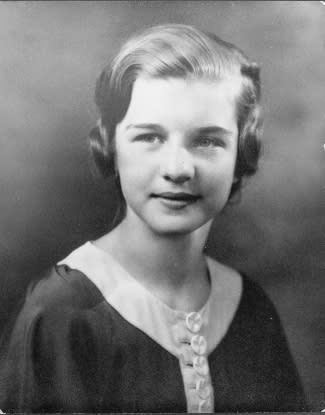
The future first lady’s first passion was dance. She studied several styles at the Calla Travis Dance Studio and even briefly opened her own while she was still in high school.
Betty spent two summers studying modern dance at Bennington College before moving to New York City and working as a dancer and a model there, before returning home to Grand Rapids at her mother’s urging.
While also teaching dance classes at the Canna Travis studio, Betty worked several other jobs, primarily at Herpolsheimer’s, a popular department store in downtown Grand Rapids. She started as a model and ended up working as the store’s fashion coordinator and clothing buyer.
During that time, she got married. She was 24 years old when she married William Warren. Though the relationship didn’t last, like everything else in her life, Betty found that those experiences shaped the person she became.
CANDOR AND HONESTY
If Betty Ford’s legacy as first lady could be boiled down into a few words, they would be candid, honest and forthcoming.
Perhaps more than anything else, Ford is known for sharing her struggles and standing up for her personal beliefs, even when they conflicted with the formal positions of her husband, the president of the United States, or the party and voters who support him.
Women’s History Month: Anna Bissell broke barriers as America’s first female CEO
Just like dance, Betty Ford was expressive and wasn’t always bound to cultural norms. Unlike some first ladies before her, she publicly expressed her own beliefs that were separate from her husband’s, and Gerald Ford supported her ability to have a difference in opinion.
Brooke Clement, the director of the Gerald R. Ford Presidential Library & Museum, says Betty Ford made life a little harder on the West Wing staff, but she wasn’t going to sit on the sidelines and the president wasn’t going to stop her from speaking her mind.
“She never shied away from being as open and candid with the American public as she possibly could,” Clement told News 8. “There were times I think that President Ford’s staff may have been a little bit shocked by some of the things that she was saying, but President Ford himself said he was not going to tell her to stop.”
A 1975 photo shows first lady Betty Ford sporting a button expressing her support for the ratification of the Equal Rights Amendment. (Courtesy Gerald R. Ford Presidential Library & Museum) Former first lady Betty Ford poses alongside first lady Rosalynn Carter at a 1977 rally in Houston, Texas, to support the campaign for the Equal Rights Amendment. (Getty Images) A 1975 photo shows first lady Betty Ford working at her desk. It is adorned with a flag that reads “Don’t Tread on Me” and “E.R.A.” (Courtesy Gerald R. Ford Presidential Library & Museum) Betty Ford hosts her first press conference as first lady on Sept. 4, 1974. (Courtesy Gerald R. Ford Presidential Library & Museum)
Betty Ford was a champion for the Equal Rights Amendment, which would guarantee equal rights for a person regardless of sex. President Ford supported the ERA, but a faction of conservative Republicans mobilized against the amendment, saying it would put some women, notably housewives, at a disadvantage.
The biographers at the National First Ladies’ Library believe her time as a working woman, along with her mother’s time supporting their family after her father’s death, helped form her opinions on women in the workplace and income inequalities.
Betty Ford appeared to be more progressive than even her husband, who himself was considered a moderate Republican. Historian Susan Hartmann called her “the most visible Republican feminist.”
Betty Ford made headlines for her frank discussions on hot-button topics, including sexual freedom, reproductive rights and marijuana use, including one prolific interview with CBS News’ Morley Safer on “60 Minutes.”
When asked about her position on abortion, Ford said, “Well, if you are asked a question, you have to be honest, say exactly how you feel. And I feel very strongly that it was the best thing in the world when the Supreme Court voted to legalize abortion and, in my words, bring it out of the back woods and put it into the hospital where it belongs.”
Women’s History Month: Learn about Grand Rapids’ women legends through walking tour
On rising marijuana use, she likened it to an experience of a teen having their first beer, even going as far to say that if she were a teen now, she may have experimented with the drug.
The “60 Minutes” piece started with a soundbite that served as an easy summary of the first lady’s attitude.
“I told my husband if we have to go to the White House, ‘OK, I will go, but I am going as myself. It’s too late to change my pattern, and if they don’t like it then they will just have to throw me out,” she said.
Plenty of conservatives soured on the Fords, writing angry letters, protesting outside the White House and voting against Ford in the 1976 Republican primaries. But the majority of the public bought in to her honest, down-to-Earth vibe.
Polling following the controversial interview saw Betty Ford’s approval numbers reach 75% — far higher than her husband’s. Ford’s 1976 campaign used her popularity to their advantage, fashion pins and signs that read “Keep Betty in the White House.”
USING HER PLATFORM
More than anything, if she was going to be thrust into the spotlight, she was going to use that spotlight to do good.
Just weeks into the Ford presidency — and while facing backlash following the president’s pardon of his predecessor, Richard Nixon — Betty Ford was diagnosed with breast cancer.
At a time when health complications were kept quiet and trust in politicians was low, the Fords made a point of being open and honest about their journey together. Whether she wanted to or not, Betty Ford knew it was the right thing to do for the country.
“It was unusual to be public about (a cancer diagnosis),” Ford said in a 2009 “PBS NewsHour” documentary. “But because my husband, when he was sworn in, had made it very clear that there would be no coverup.”
Earlier this month, her daughter, Susan Ford Bales, recalled what her mom told her the day of her diagnosis.
“She said, ‘The time for women hiding this disease in shame and behind closed doors has to stop. And who better to make that happen than the first lady of the United States?’” Ford Bales said.
A 1974 photo shows President Gerald R. Ford holding hands with the first lady while she recovers from breast cancer surgery at the Bethesda Naval Hospital. (Getty Images) President and Mrs. Ford read a petition signed by all 100 members of the United States Senate following the First Lady’s surgery for breast cancer on Oct. 2, 1974, at the Bethesda Naval Hospital. (Courtesy Gerald R. Ford Presidential Library & Museum) First lady Betty Ford takes questions from the press prior to a tour at the Guttman Institute for Early Detection of Breast Cancer on Nov. 7, 1975, in New York City. (Courtesy Gerald R. Ford Presidential Library & Museum)
Her willingness to talk openly about her diagnosis and to encourage other women to get checked sparked a surge in breast exams and mammograms. It was so notable that experts refer to it as the “Betty Ford Blip.”
“It became almost commonplace to say the word breast when it hadn’t been before. She definitely changed the landscape there for the future of women in America,” Clement said.
BEYOND THE WHITE HOUSE
Betty Ford continued to use her platform to call for progress even after her time in the White House was over. She was one of the first prominent Republicans to call attention to the AIDS epidemic and was even vocal about her disagreements over policy with future administrations. But it was another health challenge that gave Ford her legacy project: addiction treatment.
Sign up for the News 8 weekly recap newsletter
One thing that wasn’t made public during her time in the White House was Betty’s undiagnosed addiction to alcohol and prescription painkillers.
The historians with the National First Ladies’ Library believe her role as a mother and a lawmaker’s wife helped keep them in check for years. But with a lighter schedule, things got out of hand.
“In large part, the ongoing obligations to her children and public appearances factored into her control of the addiction,” their biography states. “All of it would be exacerbated by what she viewed at the time was normal alcohol consumption, routine among the cocktail parties which congressional couples were then expected to frequent.”
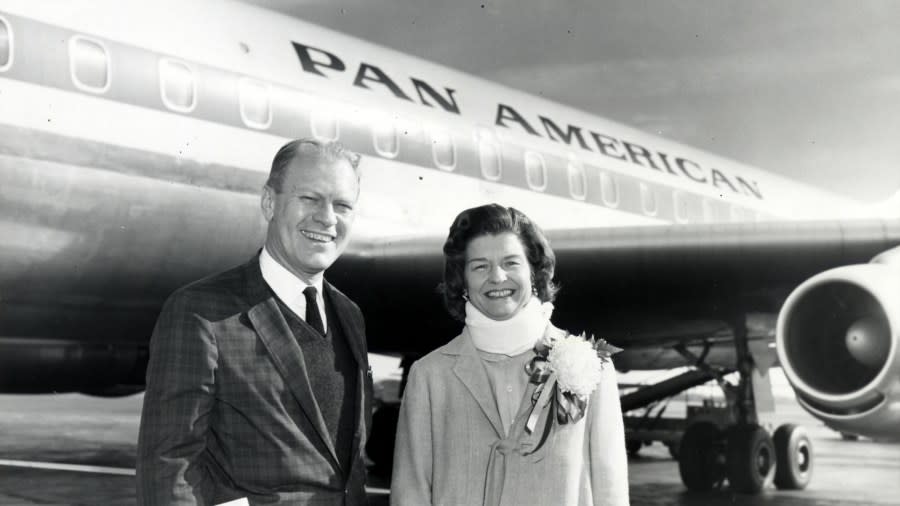
By the time of her family’s intervention in 1978, Ford had also been dependent on prescription painkillers for more than a decade. While not directly confirmed, most historians believe it stems from a pinched nerve in her neck that she suffered in 1965. Ford was hospitalized for two weeks and was prescribed Valium to deal with her chronic physical pain. She was also diagnosed with osteoarthritis, a condition that flared up while dealing with the rigors of the 1976 campaign trail.
At her family’s behest, Betty Ford enrolled in a rehabilitation program at the Long Beach Naval Hospital. It was a humbling experience for the former first lady, sharing quarters with other addicts, performing chores around the facility and participating in “emotionally revelatory therapy sessions” alongside other patients.
The legacy of Eva McCall Hamilton, Michigan’s 1st woman in state legislature
Afterward, she chose not to hide or lie, but to be honest about her hospitalization and go public with her addictions to use her platform to encourage others to seek help.
“She changed the trajectory of how people look at that kind of background — abuse and substance abuse and alcoholism. She definitely made it less of a stigma and more of a health issue,” Clement said.
Betty Ford, the chairman and co-founder of the Betty Ford Center, poses for a photo in front of the facility in 1990. Ford maintained a hands-on role at the nonprofit until 2004, when she became chairman emeritus and her daughter, Susan Ford Bales, assumed the role. (Courtesy: Betty Ford Center) Betty Ford speaks at a 1984 benefit for the American Cancer Research Center. (Getty Images)
After her treatment, Ford, along with a couple of other key supporters, founded the Betty Ford Center to provide more resources for people with substance abuse disorders, specifically women.
To provide more resources for women, the Betty Ford Center separated their patients by gender, and inadvertently found a path to greater success.
“What we also discovered in studying these patients, is that women who were in women-only halls, and men who were only in men-only halls, were doing better,” Ford Bales told PBS NewsHour. “Women wouldn’t discuss certain issues with men in the room, and men kind of felt like they had to be pumped-up and macho.”
Carolyn Cassin, the CEO of Michigan Women Forward, praises Ford for her strength, saying the idea of going public with that confession “gives her shivers.”
“The wife of the President of the United States admitted that she was an alcoholic and admitted that she had become addicted to painkillers,” Cassin told News 8. “She opened the Betty Ford Clinic and said, “Here’s a safe place, go get treated, go talk about this, go figure out why this is occurring in your life and what to do about it.’”
Meijer features local female artists for Women’s History Month
Betty Ford died in 2011. She was 93 years old. Reflecting on her life, Cassin wonders how the conversations that drive our community would be shaped today if Betty were still alive, everything from mental health to the COVID-19 pandemic.
For Cassin, Ford’s impact and legacy come down to her relatability. It wasn’t just that she was candid, open, honest and trustworthy. It’s that she was down-to-earth, with a Michigander’s sensibility.
“People would listen to her because she experienced it,” Cassin said. “I think that’s what made it so powerful.”
For the latest news, weather, sports, and streaming video, head to WOODTV.com.

